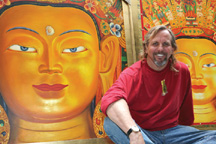 12 Ways to Realize Total Creativity From Creative Utopia - by Theo Stephan Williams |
Making Your Own Mandala
Mandala is a Tibetan word for wheel and in the physical
art form represents the circle of a belief, an awareness,
an innermost, expression from the heart. A mandala can
guide one toward self-realization and introspective self-therapy
beyond any other art form. It becomes a self-teacher,
offering messages and enlightenment. Creating a Ancient Buddhism shows us mandalas made of sand, which is still a popular material today, representing mandala art in many Buddhist communities. Sand mandalas are used to teach that time itself is impermanent; the present moment is very delicate, very beautiful; we must capture it right now. I have seen many sand mandalas in Buddhist temples in various parts of Nepal, Bhutan and Thailand. They capture an essence of fragility, the virtue of time, while telling a story of paradigms and continuity. In Tibetan culture everything has meaning, everything has great value. Words like synchronicity and coincidence do not exist there. Adjectives are collective; there are no personal pronouns. The mandala reveals a participation within the artist of his personal awakenng, feelings, transformation. Mandalas are created as a visual transformation of beliefs, and for no other reason.
The Dalai Lama recognized a world that was in great need
of healing when, in the late 1980s, he revealed to the
world many sacred Buddhist mandalas that had previously
been viewed only by traditional practitioners. The mandalas
as an art form then became a popular subject of lectures
in colleges, museums and study groups.
Paul Heussennstamm was a graduate of a well-known art
school and a successful fashion designer, partnering in
business relationships that sustained him very well. He
made the "mistake" of going to pick up his children
from an art program they were taking on Thursdays; his
wife at that time normally performed this duty, but on
this
Paul starts his mandala workshops by emphasizing the importance of ritual. Meditation, yoga, anything that can open his students to self-realization is encouraged. Paul says, "One of the things they don't teach in college is ritual and all of the good artists I know have rituals." Many times he guides students into ritual by playing very loud music - rock and roll, chanting, whatever - leading to an aroused, focused, concentrated effort to be reflective.
Choosing color and beginning the final painting of your
mandala happens after you transfer your sketch to canvas,
masonite or whichever substitute you have selected for
the final version. It is important while choosing color
that you stay focused on opening your heart instead of
your mind. The natural discipline of the mandala, forming
a circle that you build from, allows you to escape in
timelessness, taking you to a new realm of creativity.
Let the colors pick you. It will lead you to places where
you have never been but now can go naturally. It is best
in the beginning to do a mandala with a group so that
you maintain the quality of not thinking too hard.
Mandala art can widen our perspectives and throws out
many old opinions of the self. Everyone can become a mandala
artist when they find a place insde of them that is expressive.
Paul analogizes doing mandalas to having a TV with a hundred
different channels; the mandala is the same thing. Go
to your own heart and open up the Being provoked, intentionally, to introspect, results in a very positive outcome for the mandala painter. Expecting the unexpected - tranformation - has resulted in 100 percent success for Paul's students. In the history of Paul's workshops no one - not even students who have never held a paintbrush in their hands - has failed to complete a beautiful mandala.
The art of mandala painting is a stepping stone to many
discoveries about yourself. The only way to achieve creative
utopia is to accept every semblance of our artistic selves
without judgment, no rights, no wrongs. A mandala can
be a visual reminder to us in our hurried worlds that
timelessness does exist if we make a place for it.
|
